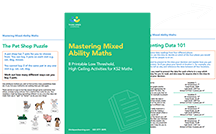How To Stretch And Challenge More Able Pupils In Maths [Even When Teaching A Mixed Ability Class]
Here we share some recommendations and stretch and challenge activities and resources to challenge your more able pupils in maths.
You may not agree with the term more able or prefer to call pupils, as I do, ‘high potential’ rather than ‘high attainers’. However, you will in your time teaching primary maths encounter pupils who just seem to be able to grasp concepts more quickly and more fluently than their peers.
The Problem With ‘More Able’ and ‘Top Set’ Labels
When it comes to ‘more able’ or ‘less able pupils’, labels can be dangerous things. We just as easily attach them to children as we do expect to see their behaviour always meet the tag we give them.
Pupils are often labelled as maths marvels from an early age because they are quick to learn, apply facts and algorithms, and can work speedily through a series of questions.
Historically this ‘most able’ labelling resulted in a child being pushed forward far too quickly and missing out on a completely rounded Maths curriculum, while their bottom set ‘low ability student’ were not challenged enough.
Just as we might misdiagnose a child as having special needs, we can equally misdiagnose a child as being mathematically talented.
And: there is no national definition of ‘most able’, abilities are not fixed and the situation is always fluid. In every primary classroom there will always be a wide range of maths ability that changes over time.
The ‘top end’ might include a few long-term residents but the doors should always be open for children to come and go. In many respects, we can argue therefore that all children are high attainers and within this group there is a subset – the highest attainers or the most able in maths.
The Teaching and Learning for Mastery Approach to Stretch and Challenge
Teaching and Leading for Mastery (TLfM) means that we have to be supremely careful about pigeon-holing as actually all children are able mathematicians but some are more able than others relative to time and context.
Read more:
- What Is Maths Mastery? The 10 Key Principles Of Teaching For Mastery In Maths
- Maths Mastery Toolkit: A Practical Guide To Mastery Teaching And Learning
High expectations in Maths are everything and we must relate these to all children. As Dame Alison Peacock tells us in her book Assessment for Learning without Limits, we can get it very wrong when “false, limiting assumptions are made about children’s capacity to learn.”
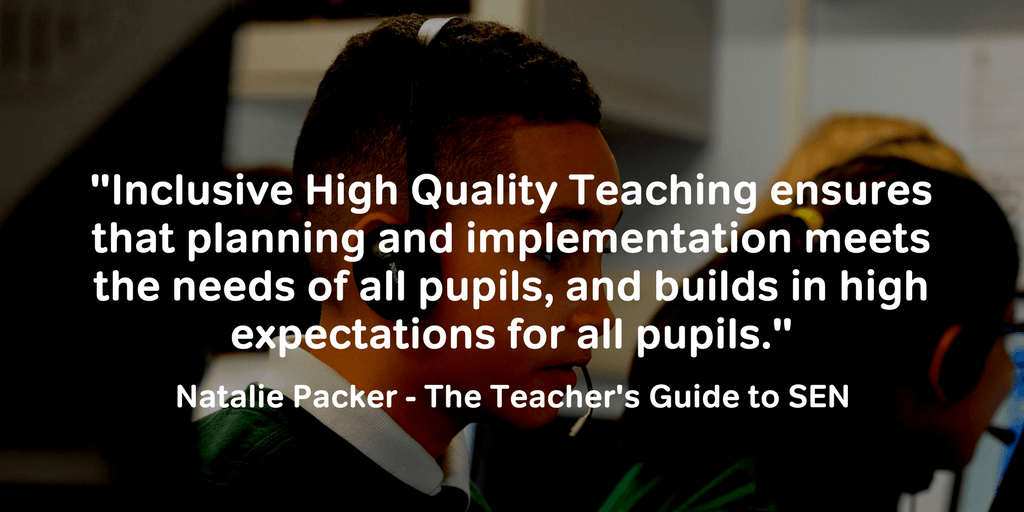
High Quality Teaching to Challenge High Prior Attainers
“Inclusive High-Quality Teaching ensures that planning and implementation meets the needs of all pupils, and builds in high expectations for all pupils.”
She says that High Quality Teaching (HQT) draws on a range of strategies that are closely matched to the learning objectives of the lesson.
Dame Peacock suggests that there are nine elements to a good quality, inclusive lesson and we need to therefore consider these when ‘stretching and challenging all pupils not just the more able in Maths:
- High expectations
- Knowing children well and developing relationship
- Inclusive environment
- Quality feedback
- Focused planning
- Engagement and challenge
- Effective questioning and modelling
- Scaffolding learning
- Developing independence
Mastering Mixed Ability Maths Resource
8 Printable Low Threshold, High Ceiling Activities for Upper and Lower Key Stage 2 Maths - Curriculum Linked for Years 3, 4, 5, 6
Download Free Now!Personalised Approaches for All Pupils in Maths
Ensuring provision for all children’s needs as part and parcel of your primary maths teaching presents some complex issues. You will need to work closely with children and take time to learn about their strengths and weaknesses, be vigilant about adopting false labels and work with others to ensure their needs in maths are met.
The needs of individual children should be evaluated on their own terms regularly, and decisions negotiated with the children themselves and their parents.
Why Stretch and Challenge Activities are Crucial for More Able or High Potential Pupils
Identifying what we can do for ‘High Potential Pupils’ (HPPs) needs to start with looking at what we shouldn’t be doing and why our efforts may be misguided or faulty.
Children can become bored easily if they are not fully challenged, leading to disruptive behaviour and disengaging with the maths.
Note to reader: I prefer the term High Potential Pupils (HPPs) when referring to those who require stretch and challenge maths activities as I believe this term is an inclusive term and encompasses any child that requires further challenge – all pupils have high potential and mathematical promise.
Ofsted evidence has found that when HPPs aren’t achieving their best that is because:
- Teacher subject knowledge is weak and can’t ‘keep up’ with particular children
- There is a failure to nurture high ambition and scholastic excellence in the subject area
- Assessment systems do not identify pupils’ potential or their prior learning
- The core reason is that planning is not good enough
- Tasks are too easy
- Tasks are the same for all
- Low expectations
- Too little challenge
- Too little support or teacher input
- Lack of checking
- Lack of opportunities to write and speak
How to Stretch and Challenge High Potential Pupils in KS2 Maths
Yet if we take these points and actually flip them on their head, we can address what we need to stretch and challenge HPPs:
- Provide opportunities to investigate new areas in depth
- Slow teaching and learning down (Thom, 2018)
- Have higher expectations of independent work and independent learning
- Develop a whole school ethos of growth mindset – even at the higher level, children need to be prepared to take risks and push through their comfort zone.
- Ensure pupils manage and plan their own learning e.g. through using knowledge organisers
- Build in writing for maths (journals/learning logs)
- Insist on better quality work
- Promote a culture of high performance
- Use searching and engaging questioning strategies
- Model complex ideas, giving explanations and demonstrations that heighten understanding with opportuitnities for higher order thinking (following Bloom’s Taxonomy)
- Instil self-belief in pupils and build-up high levels of reciprocal trust between pupils
- Integrate more interactive learning
- Make better use of assessment as part of your lesson plan
- And of course enough professional development & CPD for the primary school teacher to support pupils
For the benefit of all children when teaching mixed ability you should consider carefully the activities you choose. Where possible, these need to be open-ended, allowing children to contribute at their level.
Low threshold high ceiling activities are ideal for this.
Maths lessons really make a difference when pupils are given opportunities to think for themselves, explain their reasoning and apply what they know. As teachers we need to provide enough challenging tasks to challenge learners in and onto the range of tasks they are capable of.
Read more
- What Does Greater Depth Look Like In KS2 Maths?
- The 21 Best Maths Challenges At KS2 To Really Stretch Your More Able Primary School Pupils
- Differentiation In The Classroom: The 8 Strategies That Will Support Every Pupil To Reach A Good Standard
Concept Cartoons – The Best Maths Activities to Stretch and Challenge ‘More Able’ Pupils
The most effective resources I have ever used to stretch and extend ‘more able’ children in Maths are concept cartoons. These can be used across the key stages and even up to GCSE and A Level
Concept cartoons are problem drawings or visual arguments that use a cartoon-style format with conversations inside speech bubbles (invented by Stuart Naylor and Brenda Keogh originally in science education).
Concept cartoons are talking tools par excellence and can be influential in making the classroom a think tank, rich in dialogue and argument that genuinely extends and stretches children’s maths understanding. They are particularly useful for looking at maths misconceptions, muddles, mistakes, mix-ups and classic clangers.
Essentially, the main point of a concept cartoon is to promote cubic thinking so that learners begin to appreciate that there is always more than one way of looking at a problem, idea or way of working.
Here’s an example of a concept cartoon in relation to multiplication, where three children discuss their understanding of what it means to multiply:
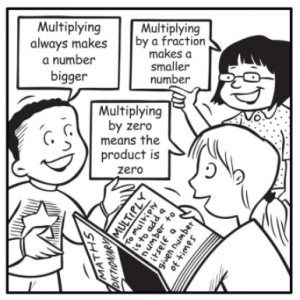
Teaching using concept cartoons can also be quite simple, as these tasks really require the pupils to do most of the work.
How to Use Concept Cartoons to Stretch and Challenge in Maths
From my experience I’ve put together a quick framework that you can use to easily stretch and extend pupils in your class using concept cartoons:
• Present learners with a cartoon that focuses on a conceptual obstacle
• Allow learners to reflect individually on the challenge
• Encourage small group discussion
• Provide opportunities for feedback across the class about the alternatives
• Try to reach agreement
• Discuss a possible line of investigation to find out more
• Hold small group enquiries
• Share outcomes of enquiries
• Whole class discussion
• Pull ideas together
• Consider how learners’ views might have changed
• Consolidate and practice
Stretch and Challenge Maths Activity: How to Use the Multiplication Concept Cartoon
Divide children into small groups of 2-3 to discuss what they think about the conversation in the picture. Do they agree with anyone in particular?
Let them talk together to share their ideas. Children need to know that the idea of a concept cartoon is to dig deeper and learn more about a range of interpretations so that we can upgrade our understanding: everyone has a contribution to make and each conversation is a stepping stone towards a fuller understanding.
Have children complete a Cognitive Conflict Evidence Board where they justify their collective thinking and provide ‘evidence’ and proof for each speech bubble statement.
It’s essential that children understand that all contributions are valued and no one’s ideas are dismissed as being ‘wrong’. Children may agree, disagree or offer a new way of looking at the concept under discussion in a way that no one else has thought about.
Here are two example boards completed by different groups:
Cognitive Conflict Evidence Boards
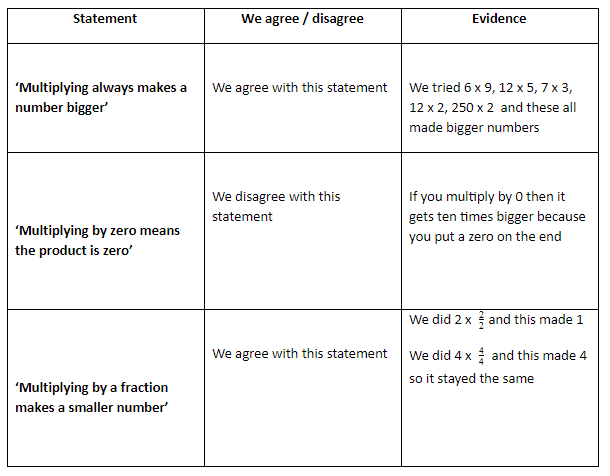
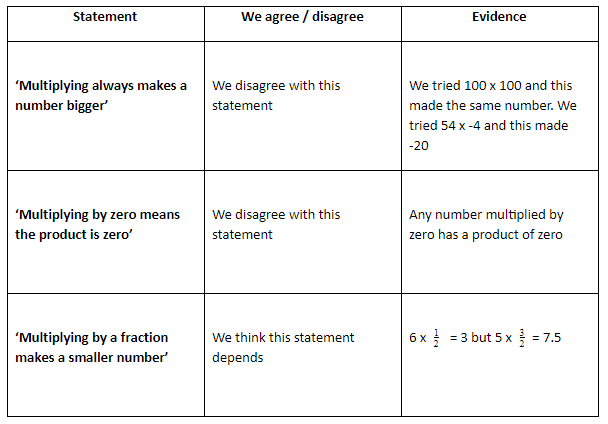
Interpreting the Answers from the Multiplication Concept Cartoons
You can see that one group have a more sophisticated understanding of multiplication in that they have analysed and dissected the statements in more depth by thinking about different numbers.
The statements undeniably stimulate different lines of thinking and you can see within these responses that there are golden opportunities to extend maths talk – the boards uncover faulty thinking and maths misconceptions as well as deeper thinking.
When presented with conflicting viewpoints then the onus is on us to scaffold and engineer conversations further and allow children to teach one another so they can cast new light on a problem or discussion.
Children can share the way they see things and show that multiplication doesn’t always make a number bigger and so the statement can be disproved, e.g. multiplying by negative numbers, proper fractions or improper fractions.
Groups might therefore decide to rephrase some statements to make them more accurate,
- ‘Multiplying two numbers together sometimes makes a bigger number.’ is more accurate.
- ‘Multiplying by a fraction makes a smaller number’, is too vague to be helpful and can be upgraded.
- Consider whether ‘Multiplying by an improper fraction makes a number bigger’ is a more accurate statement?
This can lead to some fascinating insights. One Year 6 group I worked with were keen to prove that that statement was not accurate and also needed the word ‘sometimes’ including. Why? They researched some website dictionaries to find a definition of an improper fraction as ‘a fraction where the numerator is larger than or equal to the denominator’.
They said that 7/7 was an improper fraction which, when multiplied by a whole number, would result in the same product.
From one seemingly innocent statement a whole domino effect is generated whereby children respond to each other creatively, find evidence to justify their thinking and help build layers of understanding.
In my own research into using concept cartoons I have been impressed with the way children have responded to them. I have used a variety of cartoons to address a range of conceptual obstacles and alternative frameworks.
Concept Cartoons as Extension Ideas in Maths
The concept cartoon ideas work especially well as extension tasks when you provide children with a problem that they then have to invent statements for as if voiced by others and create some Cognitive Conflict Evidence Boards for too.
For example, challenge students to craft and create their own cartoon around the following:
0.6 x 10 =
A range of responses might include:
• I think 0.6 x 10 is 10.60
• I think you have to move the decimal point to the right so it is 06
• You move the decimal point to the left so it’s 0.06
• You just add a zero
Plus, if we want to stretch and extend even more, we can ask children to systematically investigate the statements made by different students as well as any other ideas they have that aren’t represented.
Ultimately, concept cartoons are one example of how to stretch and challenge your pupils with maths activities.
But making sure our teaching allows pupils at every level (from ‘most able’ to ‘least able’) to receive the right challenges to ensure they grow and soar as mathematicians’ is what we should constantly challenge ourselves with as teachers.
Read more
DO YOU HAVE STUDENTS WHO NEED MORE SUPPORT IN MATHS?
Every week Third Space Learning’s specialist online maths tutors support thousands of students across hundreds of schools with weekly online 1 to 1 maths lessons designed to plug gaps and boost progress.
Since 2013 these personalised one to one lessons have helped over 150,000 primary and secondary students become more confident, able mathematicians.
Learn how the programmes are aligned to maths mastery teaching or request a personalised quote for your school to speak to us about your school’s needs and how we can help.

